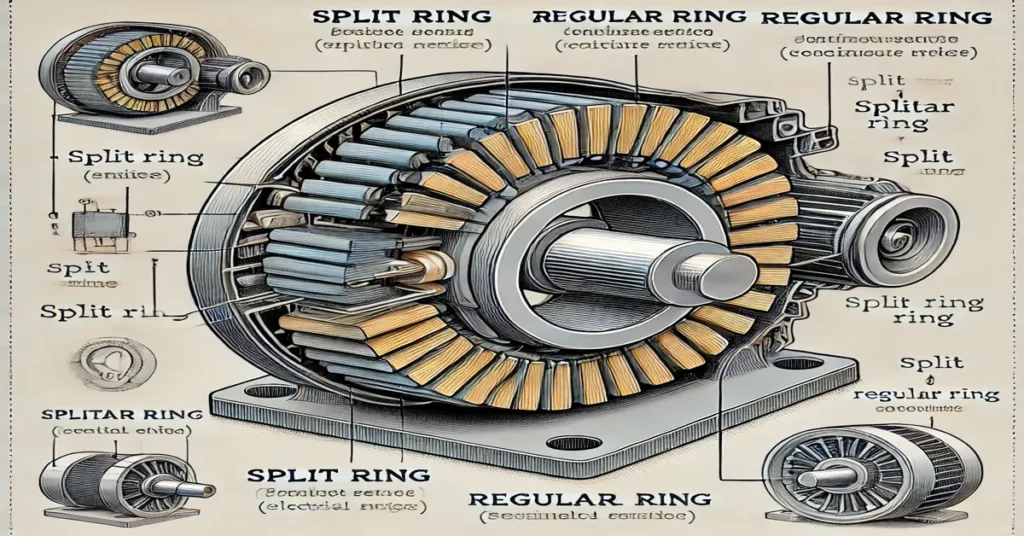In electrical engineering and physics, the terms “split ring” and “regular ring” are foundational concepts, especially in motors, generators, and electromagnetic applications. Both types of rings play essential roles in the operation and efficiency of electrical devices, yet they function very differently. Understanding the structural and functional distinctions between a split ring and a regular ring can greatly enhance one’s grasp of how various electromechanical devices work.
What is a Split Ring?
A split ring, also known as a commutator, is typically made up of two or more conductive segments separated by insulating materials. This segmented design allows for the reversal of the current direction in devices like DC (direct current) motors and generators. Each half of the split ring is attached to a separate coil, enabling the ring to reverse the flow of electricity at every half-turn.
Structure of a Split Ring
- Material Composition: Split rings are usually crafted from highly conductive materials, such as copper, and are separated by an insulating material, often mica or plastic.
- Design and Layout: The split ring consists of multiple conductive segments arranged in a circular fashion with insulation in between. This segmentation is vital for the reversal of current, as each segment contacts different points of the circuit at specific moments in rotation.
- Connection Points: Brushes, which are typically made of carbon or graphite, press against the split ring’s segments, enabling the flow of current into the rotating part of the machine.
Working Principle of a Split Ring
The split ring commutator serves a unique purpose in DC motors and generators. When the rotor completes half a rotation, the split ring reverses the direction of the current flowing through the coil. This reversal ensures that the motor continues rotating in one direction. In a DC generator, the split ring helps produce a unidirectional output from an alternating current generated in the coils.
Applications of Split Ring
Split rings are widely used in devices where the reversal of current is required, such as:
- DC Motors: The split ring allows the motor to generate continuous rotational motion in one direction.
- DC Generators: It converts alternating current into direct current at the output by reversing the coil’s current flow.
- Electromagnetic Devices: Split rings enable certain electromagnetic applications, such as oscillators, that require specific current reversal mechanisms.
What is a Regular Ring?
A regular ring, sometimes called a slip ring, is a continuous, non-segmented circular conductor. In contrast to a split ring, a regular ring does not change the direction of the current, allowing it to pass continuously without interruption. Regular rings are typically used in applications that require constant electrical connection as components rotate.
Structure of a Regular Ring
- Material Composition: Regular rings are also crafted from conductive materials like copper or brass, depending on the specific application requirements.
- Design and Layout: Unlike split rings, regular rings are seamless and unsegmented, allowing for a smooth flow of current. They are often set in pairs or in a stack of multiple rings to enable the transmission of separate currents or signals.
- Connection Points: Brushes contact the ring to allow the passage of current while the component rotates, ensuring a consistent electrical connection.
Working Principle of a Regular Ring
The regular ring’s primary purpose is to maintain a steady current flow between a rotating component and a stationary part of a machine. Since it doesn’t have segmented breaks like a split ring, it does not change the direction of current, allowing for a continuous transfer of power or data. In AC motors, the regular ring’s design supports alternating current without reversing the motion.
Applications of Regular Ring
Regular rings are commonly used in rotating machinery where a continuous connection is needed, such as:
- AC Motors: The regular ring allows AC motors to transfer current smoothly to rotating components without reversing direction.
- Wind Turbines: Regular rings enable the transmission of power from the rotating blades to the stationary power grid connection.
- Rotary Transformers and Antennas: Regular rings help in transferring data signals between rotating and stationary parts.
Key Differences Between Split Ring and Regular Ring
| Feature | Split Ring | Regular Ring |
|---|---|---|
| Purpose | Reverses current direction | Maintains continuous current flow |
| Application | DC motors, DC generators | AC motors, wind turbines |
| Structure | Segmented | Non-segmented |
| Current Flow | Reverses every half turn | Continuous |
| Use in Motors | DC motors only | AC motors and certain DC motors |
| Material | Conductive with insulating breaks | Continuous conductive material |
Why the Difference Matters: Split Ring vs. Regular Ring
The choice between a split ring and a regular ring is crucial in designing motors, generators, and other electromechanical systems. The way each type of ring handles current flow, reverses direction (or not), and interfaces with brushes directly impacts the efficiency, direction, and smoothness of the machine’s operation.
Split Ring in DC Motors
The split ring’s reversal mechanism allows DC motors to function correctly by reversing the current at each half rotation. Without a split ring, the motor would fail to sustain rotation in one direction, resulting in inefficient operation.
Regular Ring in AC Motors
In AC motors, the current’s nature requires continuous flow rather than reversal, making regular rings ideal. Since AC currents already alternate, there is no need for a split design, and the continuous nature of regular rings supports consistent, smooth operation.
Role of Insulation
The insulation in a split ring’s segmented design prevents electrical short circuits between segments, which could disrupt operation. Regular rings do not require such segmentation, as they are continuous and free from breaks, allowing uninterrupted current flow.
Advantages and Disadvantages
Advantages of Split Ring
- Current Reversal: Enables the reversal of current direction crucial for DC motors.
- Enhanced Control: Provides better control in applications where consistent directional rotation is needed.
- Optimized for DC Devices: Specifically designed to work with DC motors and generators.
Disadvantages of Split Ring
- Wear and Tear: Constant current reversal causes wear on the brushes and rings.
- Limited to DC Applications: Not suitable for AC applications due to current reversal requirements.
Advantages of Regular Ring
- Continuous Current Flow: Maintains a consistent electrical connection, making it ideal for AC motors and wind turbines.
- Durability: The non-segmented design reduces wear and extends the life of the ring.
- Versatile Applications: Suitable for any system requiring continuous current transfer.
Disadvantages of Regular Ring
- No Reversal Capability: Cannot reverse current, limiting its use in DC applications.
- Brush Friction: Brushes in contact with the ring experience friction, requiring regular maintenance.
Summary
In summary, split rings and regular rings serve distinct purposes in electrical devices, with split rings used primarily in DC motors to reverse current direction, while regular rings provide continuous current flow essential for AC motors and other rotating machinery. Both have unique designs that support their specific applications and functional needs.
Conclusion
Understanding the differences between split rings and regular rings is vital for engineers and anyone working with electromechanical devices. The decision to use one over the other depends on the specific requirements of the machine, such as the type of current, the need for continuous rotation, and the direction of the current flow. With this knowledge, you can appreciate the nuances of motor and generator design and make informed decisions in electrical engineering projects.
Frequently Asked Questions (FAQs)
- Why is a split ring used in DC motors?
- A split ring is used in DC motors to reverse the current direction every half rotation, ensuring that the motor continues rotating in one direction. This reversal allows for continuous motion, which is essential for DC motor operation.
- Can regular rings be used in DC motors?
- Regular rings are not suitable for DC motors as they do not reverse the current direction, which is necessary for DC motor rotation. Regular rings maintain a continuous current flow and are typically used in AC motors.
- What materials are used to make split rings and regular rings?
- Both split rings and regular rings are commonly made from conductive materials like copper or brass. Insulating materials, such as mica or plastic, are used in split rings to separate the segments and prevent electrical short circuits.
- Why do split rings cause more wear and tear compared to regular rings?
- Split rings undergo continuous current reversal, which causes friction and wear on the brushes and segments. This reversal action results in faster wear compared to regular rings, which maintain continuous current flow without reversing.
- What role do brushes play in split rings and regular rings?
- Brushes press against both split rings and regular rings to enable the transfer of current to the rotating part of the machine. In split rings, brushes help reverse the current, while in regular rings, they maintain a steady current flow.
- Is there an application where both split rings and regular rings are used?
- Some specialized machines or hybrid systems may incorporate both split rings and regular rings to achieve complex functionalities, such as in certain laboratory equipment or custom-designed motors. However, such combinations are uncommon and are typically tailored to specific experimental or engineering needs.







